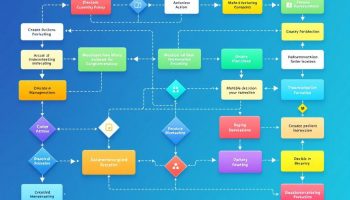
The Lean Six Sigma White Belt Course
The lean six sigma white belt course provides an essential entry point for professionals looking to achieve process excellence and boost organizational improvement. This certification introduces key methodologies and analytical tools that help you identify inefficiencies, add to continuous improvement efforts, and build critical problem-solving skills across various workplace settings.
Key Takeaways:
- A lean six sigma white belt course offers a comprehensive introduction to process improvement principles and waste reduction strategies.
- The certification provides foundational knowledge applicable across multiple industries, including manufacturing, healthcare, and service sectors.
- Participants learn to identify and analyze value-added and non-value-added process steps.
- The course equips individuals with essential tools like SIPOC diagrams, root cause analysis techniques, and waste identification methods.
- Completing the white belt certification serves as a strategic first step toward advanced six sigma credentials and organizational excellence.
Starting your quality improvement journey with a white belt certification gives you immediate advantages in today’s competitive business landscape. You’ll gain practical skills that help eliminate waste and optimize operations. The structured approach taught in these programs enables you to spot improvement opportunities that others might miss. Many organizations now value employees who understand Six Sigma fundamentals, making this certification valuable for career advancement across departments and industries.
Your participation in a white belt program also establishes a common language for process improvement within your team. This shared understanding creates a foundation for tackling complex challenges through systematic analysis rather than guesswork. Companies that implement these principles often see measurable improvements in efficiency, customer satisfaction, and cost reduction – benefits that directly impact bottom-line results and competitive positioning.
“Unlock the potential of process excellence with the Lean Six Sigma White Belt course, where foundational methodologies and analytical tools empower professionals to drive continuous improvement across diverse industries. This essential certification not only equips individuals with the skills to identify inefficiencies but also serves as a strategic stepping stone towards advanced Six Sigma credentials and organizational success.”
Core Concepts and Tools
Your journey into process excellence begins with understanding the fundamental tools provided in a lean six sigma white belt course. This entry-level certification introduces you to powerful methodologies that drive business improvement and efficiency.
The lean six sigma white belt course teaches you to identify the 8 Types of Waste that hamper organizational productivity. These wastes include overproduction, waiting, transportation, overprocessing, inventory, motion, defects, and underutilized talent. Recognizing these inefficiencies helps you contribute to streamlining operations and continuous improvement initiatives within your organization.
You’ll learn to distinguish between Value-Add (VA) and Non-Value-Add (NVA) process steps. VA activities directly contribute to meeting customer requirements, while NVA activities consume resources without adding value. This critical distinction forms the basis of process optimization in any lean six sigma white belt course.
SIPOC diagrams become an essential part of your analytical toolkit. This high-level process mapping tool helps you visualize Suppliers, Inputs, Process, Outputs, and Customers. Creating clear SIPOC diagrams enables better understanding of complex workflows and identifies improvement opportunities.
The lean six sigma white belt course introduces you to several Root Cause Analysis techniques:
- Fishbone diagrams (also called Ishikawa or cause-and-effect diagrams) that help categorize potential causes
- 5 Whys technique that drills down to underlying issues
- 5S methodology (Sort, Set in order, Shine, Standardize, Sustain) for workplace organization
You’ll develop skills to craft effective Problem Statements and Project Charters, essential documents that define improvement initiatives. These skills prove invaluable when working collaboratively on projects with colleagues at all levels of six sigma certification.
The course also covers understanding process variation, distinguishing between natural variation (common cause) and special cause variation. This knowledge helps you avoid the common pitfall of treating all process deviations the same way.
The following table summarizes the core tools you’ll master in a lean six sigma white belt course:
| Tool | Purpose | Application |
|---|---|---|
| 8 Wastes | Identify inefficiencies | Process evaluation |
| VA/NVA Analysis | Distinguish value-adding activities | Process streamlining |
| SIPOC | Map high-level processes | Process understanding |
| Fishbone Diagram | Categorize potential causes | Problem analysis |
| 5 Whys | Find root causes | Deep problem solving |
| 5S | Organize workplace | Environment optimization |
By mastering these concepts and tools through a lean six sigma white belt course, you’ll contribute to effective issue management and build a foundation for further advancement in your process improvement journey.
Companies that are highly effective at continuous improvement are 2.5 times more likely to outperform their competitors in terms of revenue and profitability.
hbr.org
Certification Process and Structure
The lean six sigma white belt course serves as your entry point into the world of process improvement and quality management. This foundational certification typically requires 6-8 hours of training, making it accessible for busy professionals seeking to enhance their skill set.
The certification process follows a straightforward structure designed for beginners. Your journey through a lean six sigma white belt course includes learning basic terminology, understanding fundamental concepts, and gaining exposure to improvement methodologies that drive organizational excellence.
Course Components and Assessment
Your certification journey includes several key components structured to build your process improvement foundation:
- Online modules covering lean principles and six sigma basics
- Interactive exercises demonstrating waste identification techniques
- Case studies illustrating successful improvement projects
- Practice assessments to reinforce learning
- Final examination testing core knowledge
The final assessment typically consists of multiple-choice and true/false questions, with a passing threshold of 80%. Unlike higher belt certifications, the white belt exam doesn’t require you to complete a practical project, making it ideal for those new to continuous improvement methodologies.
What makes the lean six sigma white belt course particularly valuable is its accessibility—there are no prerequisites, allowing anyone in your organization to participate regardless of their background or role. This inclusive approach helps create a common language for improvement across departments.
The certification structure provides a clear pathway to more advanced credentials. After completing your white belt, you can progress to yellow, green, and eventually black belt certifications, each building upon the previous level’s knowledge while introducing more sophisticated tools and techniques for process optimization.
Many organizations incorporate white belt training as part of their onboarding process, establishing a baseline understanding of lean six sigma principles across the workforce. This approach fosters a culture where employees at all levels can identify waste and contribute to efficiency initiatives.
Your lean six sigma white belt certification remains valid indefinitely, though many professionals choose to refresh their knowledge periodically as methodologies evolve. The certification provides a foundation for understanding how improvement projects are structured and managed within organizations committed to operational excellence.

Individual and Organizational Benefits
Taking a lean six sigma white belt course offers numerous advantages for both your career and your organization. This foundational certification establishes a solid platform for continuous improvement initiatives while enhancing your professional toolkit with valuable problem-solving skills.
At the individual level, completing a lean six sigma white belt course immediately improves your employability. You’ll develop analytical thinking capabilities that apply across diverse workplace scenarios. The certification demonstrates your commitment to quality management principles and positions you as someone who values efficiency and excellence. As noted in many six sigma white belt training programs, this credential often serves as your entry point to more advanced certifications like Yellow, Green, and Black Belt levels.
Organizations gain significant benefits when employees complete white belt training. The program creates a shared improvement language throughout the company, making it easier to communicate about process challenges. When team members understand basic lean principles, they can:
- Identify wasteful activities in everyday operations
- Participate meaningfully in improvement projects
- Support data-driven decision-making
- Contribute to cost reduction initiatives
- Help maintain quality standards
This foundation-level training increases employee engagement by empowering everyone to participate in process improvement. Your organization will develop a more responsive workforce capable of adapting to changing business requirements. Companies with white belt-trained staff often report improved cross-functional collaboration as teams learn to view processes holistically rather than in departmental silos.
Financial Impact and Implementation Success
The financial returns from lean six sigma white belt training can be substantial. Organizations typically see measurable improvements in efficiency, reduced waste, and enhanced quality outcomes. The continuous improvement mindset developed through this training helps identify small, incremental changes that collectively deliver significant financial benefits.
When implementing your white belt knowledge, you’ll find practical applications in daily work activities. The methodology provides a structured approach to problem-solving that reduces emotional reactions and focuses on data-driven solutions. This systematic thinking helps prevent recurring issues while building a culture of excellence.
Many organizations use white belt training as the foundation for broader transformation initiatives. By establishing a critical mass of employees with this basic understanding, you create the conditions for sustainable change. The lean six sigma white belt course serves as an essential catalyst for organizational improvement, providing both immediate skills and a pathway to deeper process excellence expertise.

Industry-Wide Applications
A lean six sigma white belt course provides foundational knowledge that you can apply across virtually any industry. This entry-level certification isn’t limited to manufacturing environments—it offers practical value in diverse sectors where process improvement can drive better results.
In manufacturing, white belt knowledge helps you identify and eliminate the eight wastes, particularly in production lines. You’ll spot unnecessary movement, waiting time, and inventory issues that increase costs. Your ability to distinguish value-add from non-value-add activities becomes especially relevant when analyzing assembly processes or equipment efficiency.
Healthcare organizations leverage lean six sigma principles to enhance patient care and reduce costs. After completing a lean six sigma white belt training, you’ll recognize opportunities to streamline patient admissions, reduce waiting times, and minimize errors in medication administration. These improvements directly impact patient satisfaction and safety outcomes.
Service industries benefit significantly from white belt methodologies. Financial institutions apply these concepts to transaction processing, customer service protocols, and compliance procedures. Retail operations use them to optimize inventory management and checkout experiences. The DMAIC framework (Define, Measure, Analyze, Improve, Control) works equally well for improving service delivery as it does for physical products.
Supporting Organizational Change
Government agencies increasingly adopt lean six sigma white belt course principles to enhance operational efficiency. You’ll find applications in permit processing, document management, and citizen service delivery. The focus on eliminating waste helps public sector organizations do more with limited resources.
White belts serve as valuable change agents within organizations implementing continuous improvement initiatives. Your understanding of basic problem-solving tools enables you to support continuous improvement projects even in non-operational roles like human resources, finance, or marketing. This cross-functional applicability makes the certification particularly valuable.
The lean six sigma white belt course equips you with a structured approach to problem-solving that transcends industry boundaries. Whether you work in technology, education, construction, or hospitality, the principles remain consistent—identify waste, measure current performance, analyze root causes, implement improvements, and establish controls to sustain gains.
Many organizations use white belt training as an entry point to build a culture of continuous improvement. By providing all employees with this foundation, companies create a common language and methodology for addressing process challenges at every level.

Implementing White Belt Knowledge
After completing your lean six sigma white belt course, you’ll need practical strategies to apply these newfound skills in your workplace. The white belt certification serves as your foundation for process improvement, enabling you to support larger organizational initiatives while developing your own improvement capabilities.
You can immediately implement white belt knowledge by identifying waste in your daily processes. Look for opportunities to eliminate unnecessary steps that don’t add value to your customers or organization. The lean six sigma white belt course teaches you to recognize the 8 types of waste: transportation, inventory, motion, waiting, overproduction, overprocessing, defects, and skills underutilization.
Try these practical application strategies to maximize your white belt training:
- Document current processes using SIPOC diagrams to visualize suppliers, inputs, processes, outputs, and customers
- Apply 5S methodology (Sort, Set in order, Shine, Standardize, Sustain) to organize your workspace
- Use root cause analysis techniques like 5 Whys when problems arise
- Collect basic process data to support decision-making
- Participate in team problem-solving sessions using your new improvement vocabulary
Your white belt certification positions you to support continuous improvement efforts across departments. When integrated with existing workflows, these techniques create tangible business results without disrupting operations. The lean six sigma white belt course provides the vocabulary and concepts needed to communicate effectively with higher-level belt holders.
Building Your Improvement Career
The white belt represents your entry point into the world of process excellence. From here, you can pursue several development paths that build on your lean six sigma white belt course knowledge:
- Advance to Yellow Belt for deeper statistical tools understanding
- Pursue Green Belt certification to lead smaller improvement projects
- Consider Black Belt training for full-time improvement leadership roles
- Apply skills in project management software to track improvement initiatives
Organizations benefit when employees at all levels understand improvement methodologies. Your white belt training helps establish a culture where everyone speaks the same process improvement language. This shared understanding accelerates change initiatives and reduces resistance to new approaches.
The lean six sigma white belt course equips you with practical tools to address everyday operational challenges. By consistently applying these methods, you’ll strengthen your problem-solving muscles and develop valuable skills that transfer across industries and roles.






